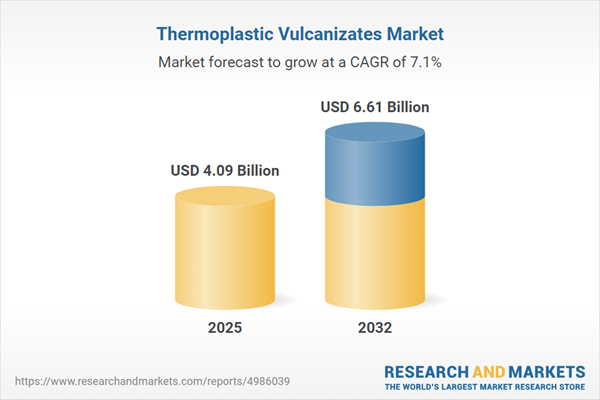Speak directly to the analyst to clarify any post sales queries you may have.
Thermoplastic vulcanizates are redefining materials selection for executive teams seeking compliance, adaptability, and robust supply management in changing global markets. Their unique properties allow organizations to advance innovation, sustainability, and risk mitigation in critical operations.
Market Snapshot: Thermoplastic Vulcanizates Market Trends and Outlook
The global thermoplastic vulcanizates market is projected to reach USD 3.82 billion in 2024, demonstrating an anticipated compound annual growth rate (CAGR) of 7.08%. This momentum is driven by progress in elastomer chemistry and improved manufacturing methods. Leading companies are prioritizing chemical innovation and precise process control, enabling more customized offerings tailored for emerging regulatory requirements and deepening system integration. As senior decision-makers confront demands for enhanced compliance and operational performance, thermoplastic vulcanizates are supporting the expansion of modern strategies across principal industries.
Scope & Segmentation of the Thermoplastic Vulcanizates Market
- Product Types: EPDM-based thermoplastic vulcanizates deliver resilience and versatility, suitable for advanced engineering in high-stress environments. PP-based compounds are recognized for cost-efficiency and their use in applications that require scalable solutions. PVC-based options offer strong chemical resistance and electrical insulation, ensuring safety and functional reliability in sensitive sectors.
- Processing Technologies: Manufacturers utilize blow molding, calendering, extrusion, and injection molding, allowing rapid adaptation to varied production needs. This range of manufacturing processes makes it possible to accommodate tailored orders and maintain quality across diverse product categories.
- End-Use Industries: The automotive sector leverages these materials to reduce vehicle weight and increase operational efficiency. Construction benefits from compliance advantages and the flexibility required for durable installations. Consumer products adopt thermoplastic vulcanizates for their tactile features, while electronics industries seek optimized insulation. Healthcare relies on their consistent physical properties and robust safety profile.
- Distribution Channels: Supply management occurs through direct procurement from original equipment manufacturers and through aftermarket partnerships, enabling organizations to meet fluctuating inventory needs with increased agility.
- Geographical Presence: The market operates across the Americas, Europe, the Middle East and Africa, and Asia-Pacific. Companies tailor regional strategies to align with local regulations and specific economic factors, pursuing competitive advantages through targeted localization.
- Leading Companies Profiled: Notable providers include Avient Corporation, The Dow Chemical Company, BASF SE, Kraton Corporation, Teknor Apex Company, LANXESS AG, Mitsui Chemicals, ExxonMobil Chemical, Wacker Chemie AG, and Zylog ElastoComp LLP. These leaders are advancing sustainable practices and refining operations to navigate increasingly complex regulatory environments.
Key Takeaways for Senior Decision-Makers
- Shifting to bio-based and specialty thermoplastic vulcanizates supports corporate sustainability and strengthens the ability to respond to evolving standards.
- Deploying digital process controls and analytics fosters end-to-end visibility, enhancing quality management while enabling rapid corrective action during production.
- Collaborative research and development between internal teams and external suppliers increases organizational agility in response to regulatory and market changes.
- Expanding regional and local sourcing capabilities mitigates supply chain vulnerabilities and advances proactive risk management.
- Investment in advanced production technologies offers scalable manufacturing solutions, positioning organizations to achieve long-term strategic goals in the thermoplastic vulcanizates sector.
Tariff Impact: Sourcing and Supply Chain Adaptation in the Thermoplastic Vulcanizates Sector
New and existing tariffs affecting elastomeric materials in the United States are spurring a transition to domestic and regional supply sources. This shift is essential for organizations seeking to minimize global trade risk and ensure consistent operations in increasingly regulated markets.
Methodology & Data Sources
This market report is grounded in in-depth executive interviews, targeted industry surveys, and comprehensive reviews of regulatory records and intellectual property documents. This thorough approach creates a balanced perspective on shifting supply dynamics, emerging policy trends, and the evolving priorities of key decision-makers.
Why This Report Matters
- Delivers actionable insights for investment and technology strategy, supporting modernization and future readiness in compliance-driven environments.
- Enhances data-driven supplier selection and improves risk management within the evolving thermoplastic vulcanizates market.
- Offers clear guidance on market competitiveness, aiding strategic planning focused on sustainable, long-term organizational growth.
Conclusion
Thermoplastic vulcanizates equip leadership with effective strategies for compliance and supply chain strength. This report empowers organizations to make informed, adaptive choices, positioning them for success as the market continues to evolve.
Additional Product Information:
- Purchase of this report includes 1 year online access with quarterly updates.
- This report can be updated on request. Please contact our Customer Experience team using the Ask a Question widget on our website.
Table of Contents
3. Executive Summary
4. Market Overview
7. Cumulative Impact of Artificial Intelligence 2025
Companies Mentioned
The companies profiled in this Thermoplastic Vulcanizates market report include:- Avient Corporation
- The Dow Chemical Company
- BASF SE
- Kraton Corporation
- The Teknor Apex Company, LLC
- LANXESS AG
- Mitsui Chemicals, Inc.
- ExxonMobil Chemical Company
- Wacker Chemie AG
- Zylog ElastoComp LLP
Table Information
| Report Attribute | Details |
|---|---|
| No. of Pages | 197 |
| Published | November 2025 |
| Forecast Period | 2025 - 2032 |
| Estimated Market Value ( USD | $ 4.09 Billion |
| Forecasted Market Value ( USD | $ 6.61 Billion |
| Compound Annual Growth Rate | 7.0% |
| Regions Covered | Global |
| No. of Companies Mentioned | 11 |









